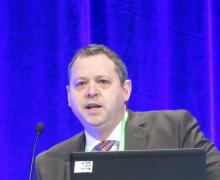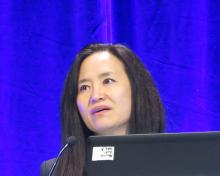ATLANTA – For patients with locally advanced head and neck squamous cell carcinomas positive for human papillomavirus type 16, neoadjuvant therapy with the immune checkpoint inhibitor nivolumab combined with stereotactic body radiation therapy (SBRT) was associated with high response rates and a lower toxicity profile compared with the current standard of care, results of a phase 1/1b study suggest.
All of five patients treated with SBRT doses of 8 Gy per day for 5 days (40 Gy total) had pathologic complete responses (pCR), as did four of five patients treated at a deescalated SBRT dose of 8 Gy on alternating days for 3 days (24 Gy total), reported Rom S. Leidner, MD, of Providence Cancer Center in Portland, Ore.
“We’ve met the primary endpoint. This approach certainly was safe as far as not preventing definitive surgery. The potency was much greater than expected, with a pCR rate of 90% and a major response in 100% of patients,” he said at the annual meeting of the American Association for Cancer Research.
Dr. Leidner and colleagues are investigating therapies for locally advanced HPV-associated head and neck squamous cell carcinoma (HNSCC) that are as effective as but less toxic than the current standard of care: definitive chemoradiotherapy or surgery followed by risk-adapted adjuvant radiotherapy with or without chemotherapy.
They enrolled 10 patients, all men, with a mean age of 64.5 years. Seven patients had HPV16-positive oropharyngeal HNSCC, and three had unknown primary HNSCC (HPV-positive lymph nodes in the neck without an identifiable mucosal primary site). All patients had clinical indications for adjuvant radiotherapy or upfront transoral robotic surgery (TORS) but were ineligible because of tumor size.
The patients were assigned to one of two dose-finding cohorts in groups of five each to receive nivolumab (Opdivo) 240 mg intravenously every other week for three cycles prior to surgery, with SBRT to gross tumor volume plus 3 mm delivered between the first and second doses of nivolumab.
One cohort of patients received SBRT 8 Gy daily for 5 consecutive days (Monday-Friday), and the other received deescalated SBRT 8 Gy delivered on alternating days (Monday, Wednesday, Friday).
Patients underwent surgery 5 weeks after SBRT, and 4 weeks after surgery were started on adjuvant nivolumab 480 mg IV every 4 weeks for three cycles.
The trial met its primary endpoint of fewer than one-third of patients having an unplanned surgical delay. None of the 10 patients required a surgical delay, in fact.
Although all patients had radiologic evidence of tumor shrinkage prior to surgery, there were no complete responses according to Response Criteria in Solid Tumors (RECIST, version 1.1). Seven patients had a partial response (PR), and three had stable disease.
Dr. Leidner noted that when a patient with stable disease according to RECIST went to surgery “we found a [pCR] in the primary site, and residual cancer in the neck nodes with less than 10% viable tumor cells and evidence of immune eradication.”
As noted, all five patients in the 40-Gy dose group had complete pathologic responses, as did four of the five patients in the deescalated dose group. The remaining patient in this group had a major pathologic response, with less than 10% residual tumor.
“The secondary tissue endpoint far exceeded our expectations on this trial,” Dr. Leidner said.
There were no reports of acute toxicity in the neoadjuvant phase, but delayed mucositis (grade 1 or 2) and immune-related grade 1 dermatologic and rhinitis events were seen. Mucositis resolved by week 4 in all patients, at least 2 weeks before surgery.
Postoperative delayed toxicities up to grade 3 were seen, with delays in mucosal healing in patients who underwent mucosal resections; there were no cases of delayed healing among patients who underwent neck dissection only.
Grade 3 oropharyngeal pain requiring opiates for more than 4 weeks after surgery was seen in both cohorts, but lasted longer among patients in the 8-Gy-times-5 cohort.
Half of all patients were found to have adrenal insufficiency, a rate higher than that previously reported with the use of anti-PD-1 immune checkpoint inhibitors in HNSCC, Dr. Leidner said.
“Clinically we’re seeing, as one might expect, substantially reduced xerostomia and ageusia, but that was not formally measured,” he said.
Based on the study findings, investigations are proceeding at the deescalated dose.
Invited discussant Christine H. Chung, MD, of H. Lee Moffitt Cancer Center and Research Institute in Tampa, did not appear to share Dr. Leidner’s enthusiasm for the approach, saying that “overall, path CR in already resectable patients with an extremely high cure rate may not be clinically meaningful.”
She said that the role of adjuvant nivolumab following neoadjuvant nivolumab, radiotherapy, and surgery in HPV-positive patients is unclear, and that “the approach may be more suitable for HPV-negative patients with poor prognosis and in need of treatment intensification.”
Providence Cancer Center sponsored the study. Dr. Leidner reported having no relevant disclosures. Dr. Chung reported research funding from Lilly Oncology, and advisory board honoraria from BMS, CUE, and Ignyta.
SOURCE: Leidner RS et al. AACR 2019, Abstract CT182.



